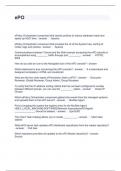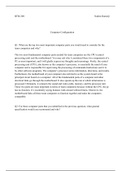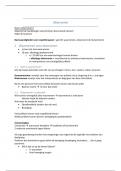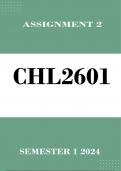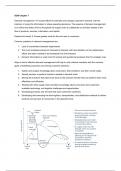Wartime Conferences - These were the 3 main conferences:
Tehran Conference (Nov 1943)
People Involved: Churchill, Roosevelt, and Stalin
Focus: Coordination of military strategy and post-war plans
Outcome: Strengthened the wartime alliance between the Western Allies and the USSR
Key Agreement: Britain and the US decided not to invade Germany through Greece, allowing the Red
Army to defeat the Germans in Eastern Europe.
Significance: This agreement marked a pivotal shift in military strategy and underscored the cooperation
and mutual reliance among the Allies.
Yalta Conference (Feb 1945)
People Involved: Churchill, Roosevelt, and Stalin
Discussion Points:
o Germany and Berlin would be divided into four temporary zones controlled by the Americans,
British, French, and Soviets.
o Stalin wanted to move westwards into Germany to secure his borders.
o Churchill opposed these border shifts.
o Disagreements over Poland created tensions as Stalin wanted to protect his country by ensuring
a friendly government in Poland.
Significance: This conference highlighted the emerging ideological differences between the Allies, setting
the stage for post-war conflicts.
Potsdam Conference (July-August 1945)
People Involved: Stalin, Truman, and Churchill (later replaced by Attlee)
Discussion Points:
o The Allies disagreed on the fate of Germany.
o Stalin wanted to cripple Germany and make it pay reparations.
o Truman wanted to help Germany recover from the war so that it could trade with the USA.
o Truman made sure that Stalin knew the USA had an atomic bomb.
o Tensions intensified over these disagreements.
Significance: Therefore, Truman adopted a tough personality towards the USSR. These disagreements
highlighted the growing mistrust and ideological differences that would soon lead to the Cold War.
Disagreements
Different Objectives for Germany: Stalin wanted to ensure Germany would not rise again as a military
threat by crippling it economically and demanding reparations. In contrast, Truman aimed for Germany's
economic recovery to promote stability and create a trading partner for the USA.
Ideological Differences: Stalin's desire to expand Soviet influence in Eastern Europe clashed with
Truman's goal of containing communism and promoting democracy and free-market economies.
Atomic Bomb Revelation: Truman's disclosure of the atomic bomb to Stalin was a demonstration of
power, increasing Stalin's distrust and prompting an arms race.
Border and Political Tensions: Disagreements over the future political landscape of Europe, especially
concerning Poland, created deep-seated tensions between the Allies. Stalin's insistence on a pro-Soviet
government in Poland was seen as an expansion of communist influence, which Churchill and Truman
opposed.
The USSR still felt threated by the west because they had develop an atomic bomb, He wanted to protect the USSR
by taking control of countries in Eastern Europe during the war.
1
, So therefore USSR started to expand its ideology over Eastern Europe. Establishing communist governments
closely controlled by Moscow in Poland, Hungary, Czechoslovakia, Yugoslavia, Albania, Bulgaria, and East Germany.
These countries became known as Soviet satellite states, economically and politically dependent on the USSR.
This is why Stalin was not cooperating in the Yalta and Potsdam conference, He saw any suggestions to settle
issues as a threat to the USSR's safety.
What was the USA reaction of the West to USSR Control over Eastern Europe
The west was worried because they sow Stalin as a dictator, leading Winston Churchill to develop his iron curtain
speech in 1946 . Where he discussed that is dividing Europe into two parts and one side free democratic countries
and the other side behind the iron curtain were contras under the communist control by the USSR
Stalin did not agree with the iron curtain speech and saw it as a threat in order to start a war but this did not stop
him from expanding communism in Eastern Europe.
The Policy of Containment, the Truman Doctrine and Marshall Plan
The Policy of Containments the Truman doctrine and Marshall Plan were the response to the salami technique of
Stalin in order to stop the spread of communism .Truman was scared that west could fall into communism
During the early stages of the Cold War, the USA played a pivotal role in countering the spread of communism in
various countries. In Greece, Turkey, Iran, Italy, and France, American intervention was driven by the fear of Soviet
influence and the domino theory. Through economic aid, military support, and political pressure, the USA helped
stabilize these nations, ensuring they remained aligned with Western democratic values. This strategy not only
curtailed Soviet expansion but also laid the groundwork for a sustained American presence in global geopolitics,
shaping the international order for decades to come.
Truman doctrine
The Truman Doctrine was a policy announced by President Harry S. Truman in 1947. It stated that the United
States would provide economic and military aid to countries threatened by communism. The main goal was to stop
the spread of communism and support free nations in maintaining their independence.
Greece
After the Nazis left in 1944, a civil war started between communists and monarchists.
The British, who had freed Greece, couldn't control the Greek communists.
Greek communists were backed by nearby communist states like Yugoslavia, Bulgaria, and Albania.
The British asked the USA for assistance to avoid a prolonged civil war. Domino Theory, President Truman
believed that if one country fell to communism, others nearby would also be at risk (domino effect).
Truman Doctrine: In March 1947, Truman declared that America would support free people resisting
subjugation.
The USA provided massive arms and other supplies to Greece, leading to the defeat of the communists.
Therefore, he British, unable to contain the conflict, sought American help. President Truman, believing it
was crucial to support nations resisting communist control, stepped in with substantial military aid and
resources. This American intervention helped defeat the communists in Greece, marking a significant
moment in the early Cold War and the beginning of the Truman Doctrine.
Turkey
Turkey, like Greece, faced pressure from the Soviet Union. In 1945-1946, Stalin demanded Turkey return provinces
gained from Russia after WWI. In response, Turkey sought help from Western powers. The USA stepped in, making
it clear they would not tolerate Soviet aggression. They provided significant aid, part of the $400 million allocated
to both Greece and Turkey, to help resist communist revolutions and support democracy. This intervention was
part of the broader strategy to contain communism during the Cold War.
2


